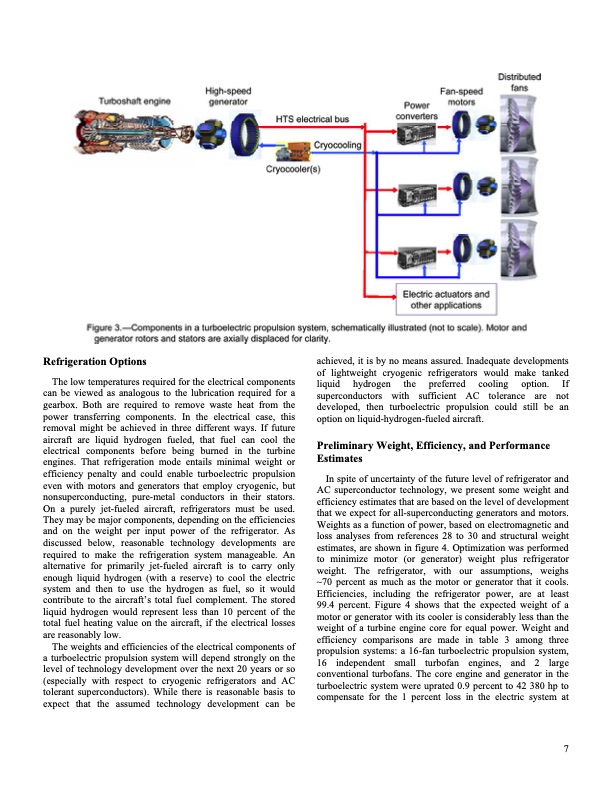
PDF Publication Title:
Text from PDF Page: 008
Refrigeration Options The low temperatures required for the electrical components can be viewed as analogous to the lubrication required for a gearbox. Both are required to remove waste heat from the power transferring components. In the electrical case, this removal might be achieved in three different ways. If future aircraft are liquid hydrogen fueled, that fuel can cool the electrical components before being burned in the turbine engines. That refrigeration mode entails minimal weight or efficiency penalty and could enable turboelectric propulsion even with motors and generators that employ cryogenic, but nonsuperconducting, pure-metal conductors in their stators. On a purely jet-fueled aircraft, refrigerators must be used. They may be major components, depending on the efficiencies and on the weight per input power of the refrigerator. As discussed below, reasonable technology developments are required to make the refrigeration system manageable. An alternative for primarily jet-fueled aircraft is to carry only enough liquid hydrogen (with a reserve) to cool the electric system and then to use the hydrogen as fuel, so it would contribute to the aircraft’s total fuel complement. The stored liquid hydrogen would represent less than 10 percent of the total fuel heating value on the aircraft, if the electrical losses are reasonably low. The weights and efficiencies of the electrical components of a turboelectric propulsion system will depend strongly on the level of technology development over the next 20 years or so (especially with respect to cryogenic refrigerators and AC tolerant superconductors). While there is reasonable basis to expect that the assumed technology development can be achieved, it is by no means assured. Inadequate developments of lightweight cryogenic refrigerators would make tanked liquid hydrogen the preferred cooling option. If superconductors with sufficient AC tolerance are not developed, then turboelectric propulsion could still be an option on liquid-hydrogen-fueled aircraft. Preliminary Weight, Efficiency, and Performance Estimates In spite of uncertainty of the future level of refrigerator and AC superconductor technology, we present some weight and efficiency estimates that are based on the level of development that we expect for all-superconducting generators and motors. Weights as a function of power, based on electromagnetic and loss analyses from references 28 to 30 and structural weight estimates, are shown in figure 4. Optimization was performed to minimize motor (or generator) weight plus refrigerator weight. The refrigerator, with our assumptions, weighs ~70 percent as much as the motor or generator that it cools. Efficiencies, including the refrigerator power, are at least 99.4 percent. Figure 4 shows that the expected weight of a motor or generator with its cooler is considerably less than the weight of a turbine engine core for equal power. Weight and efficiency comparisons are made in table 3 among three propulsion systems: a 16-fan turboelectric propulsion system, 16 independent small turbofan engines, and 2 large conventional turbofans. The core engine and generator in the turboelectric system were uprated 0.9 percent to 42 380 hp to compensate for the 1 percent loss in the electric system at 7PDF Image | Distributed TurboElectric Propulsion for Hybrid Wing Aircraft

PDF Search Title:
Distributed TurboElectric Propulsion for Hybrid Wing AircraftOriginal File Name Searched:
20080021214.pdfDIY PDF Search: Google It | Yahoo | Bing
NFT (Non Fungible Token): Buy our tech, design, development or system NFT and become part of our tech NFT network... More Info
IT XR Project Redstone NFT Available for Sale: NFT for high tech turbine design with one part 3D printed counter-rotating energy turbine. Be part of the future with this NFT. Can be bought and sold but only one design NFT exists. Royalties go to the developer (Infinity) to keep enhancing design and applications... More Info
Infinity Turbine IT XR Project Redstone Design: NFT for sale... NFT for high tech turbine design with one part 3D printed counter-rotating energy turbine. Includes all rights to this turbine design, including license for Fluid Handling Block I and II for the turbine assembly and housing. The NFT includes the blueprints (cad/cam), revenue streams, and all future development of the IT XR Project Redstone... More Info
Infinity Turbine ROT Radial Outflow Turbine 24 Design and Worldwide Rights: NFT for sale... NFT for the ROT 24 energy turbine. Be part of the future with this NFT. This design can be bought and sold but only one design NFT exists. You may manufacture the unit, or get the revenues from its sale from Infinity Turbine. Royalties go to the developer (Infinity) to keep enhancing design and applications... More Info
Infinity Supercritical CO2 10 Liter Extractor Design and Worldwide Rights: The Infinity Supercritical 10L CO2 extractor is for botanical oil extraction, which is rich in terpenes and can produce shelf ready full spectrum oil. With over 5 years of development, this industry leader mature extractor machine has been sold since 2015 and is part of many profitable businesses. The process can also be used for electrowinning, e-waste recycling, and lithium battery recycling, gold mining electronic wastes, precious metals. CO2 can also be used in a reverse fuel cell with nafion to make a gas-to-liquids fuel, such as methanol, ethanol and butanol or ethylene. Supercritical CO2 has also been used for treating nafion to make it more effective catalyst. This NFT is for the purchase of worldwide rights which includes the design. More Info
NFT (Non Fungible Token): Buy our tech, design, development or system NFT and become part of our tech NFT network... More Info
Infinity Turbine Products: Special for this month, any plans are $10,000 for complete Cad/Cam blueprints. License is for one build. Try before you buy a production license. May pay by Bitcoin or other Crypto. Products Page... More Info
| CONTACT TEL: 608-238-6001 Email: greg@infinityturbine.com | RSS | AMP |